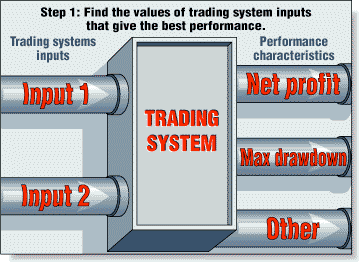MONEY MANAGEMENT
System Optimization And Money Management
by Leo J. Zamansky, Ph.D., and Markus Stolz
Most traders focus on optimizing the trading system rules and ignore money management rules until after the system rules have been established. Here's why you should test both sets of rules simultaneously.
Modern charting and analysis software for traders is equipped with the ability to optimize inputs for a trading system. To optimize inputs, first, a system must be run for each combination of input values within the set limits and with a given setup. The result is a table that has for each set of input values a corresponding set of performance characteristics. Second, one set of values with the best performance is chosen. The best performance does not mean the highest net profit or minimum drawdown; it can be any combination of acceptable performance characteristics.

FIGURE 1: STEP 1. Find the values of trading system inputs that give the best performance.
Money management is used to improve and ultimately maximize the return on an account by determining the amount to invest. Properly used, money management can dramatically change trading performance. There are several well-known money management strategies such as fixed fractional, optimal f, secure f, martingale, antimartingale, as well as others.
Strategies such as optimal f, martingale, and antimartingale are based on the returns of the trades. That means the amount of money to invest in each trade and the overall profitability of the strategy depends on the profits/losses of the historical trades.
Traders often apply optimization to find the best input values for a system and then use money management to maximize system returns. This is the way most of the software packages have been developed. However, for system trading, this isn't quite right. Money management strategies have been widely discussed, but not in application to a mechanical system with optimizable inputs. We do here.
The demonstration will be based on optimal f, but it is equally applicable to any money management strategy that depends only on returns.
PROBLEM DEFINITION
Optimal f is known as the optimum fraction of the capital available to invest in a trade to maximize the return of a system (see sidebar, "What is optimal f?"). This assumes that the user has already selected a trading strategy and defined its parameters. Now, how much capital should be invested on each trade?
Let us assume that we have a moving average crossover system with two inputs, FastMA and SlowMA. Before optimal f is applied, a trader has already determined the values for FastMA and SlowMA for the system inputs. Figures 1 and 2 describe the present use of optimization and money management.
Leo Zamansky, Ph.D., is president of Rina Systems in Cincinnati, OH, a firm that specializes in performance analysis software for traders and investors. Rina Systems is the developer of Money Manager, Portfolio Evaluator, 3D SmartView, and the Dynamic Zones indicator. Free software, including the Secure f Calculator, can be downloaded from https://www.rinasystems.com/download. Rina Systems can be reached at info@rinasystems.com or at https://www.rinasystems.com. Markus Stolz is a London-based professional derivatives trader. He has also worked as an OTC options trader for several investment houses. He also works with Rina Systems on performance analysis tools and can be reached under Markus.Stolz@btinternet.com. The authors thank David Stendahl and James Goldcamp for their comments and suggestions.
Excerpted from an article originally published in the August 1999 issue of Technical Analysis of STOCKS & COMMODITIES magazine. All rights reserved. © Copyright 1999, Technical Analysis, Inc.
Return to August 1999 Contents